GAU-8 Avenger
| GAU-8 Avenger | |
|---|---|
|
The GAU-8/A Avenger's barrel and breech assembly (ammunition drum off right edge of photo). | |
| Type | Gatling-type autocannon |
| Place of origin | United States |
| Service history | |
| In service | 1977–present |
| Used by |
United States Air Force (Avenger) Various navies (Goalkeeper) |
| Production history | |
| Manufacturer | General Electric |
| Number built | Approx. 715[1] |
| Variants |
GAU-12/U Equalizer GAU-13/A |
| Specifications | |
| Weight | 619.5 lb (281 kg) |
| Length |
19 ft 10.5 in (6.06 m) (total system) 112.28 in (2.85 m) (gun only) |
| Barrel length | 90.5 in (2.30 m) |
| Width | 17.2 in (0.437 m) (barrels only) |
|
| |
| Cartridge | 30×173 mm |
| Caliber | 30 mm caliber |
| Barrels | 7-barrel (progressive RH parabolic twist, 14 grooves) |
| Action | Electrically controlled, Hydraulic-Driven |
| Rate of fire | 4,200 rpm (variable) |
| Muzzle velocity | 3,324 ft/s (1,010 m/s) (API) |
| Effective firing range | 4,000 feet (1,220 m) |
| Maximum firing range | Over 12,000 feet (3,660 m) |
| Feed system | Linkless feed system |
The General Electric GAU-8/A Avenger is a 30 mm hydraulically driven seven-barrel Gatling-type autocannon that is typically mounted in the United States Air Force's Fairchild Republic A-10 Thunderbolt II. Designed specifically for the anti-tank role, the Avenger delivers very powerful rounds at a high rate of fire. The GAU-8/A is also used in the Goalkeeper CIWS ship weapon system, which provides defense against short-range threats such as highly maneuverable missiles, aircraft, and fast maneuvering surface vessels.
History
The GAU-8 was created as a parallel program with the A-X (or Attack Experimental) competition that produced the A-10. The specification for the cannon was laid out in 1970,[2] with General Electric and Philco-Ford offering competing designs. Both of the A-X prototypes, the YA-10 and the Northrop YA-9, were designed to incorporate the weapon, although it was not available during the initial competition; the M61 Vulcan was used as a temporary replacement. Once completed, the entire GAU-8 assembly (correctly referred to as the A/A 49E-6 Gun System)[3] represents about 16% of the A-10 aircraft's unladen weight. Because the gun plays a significant role in maintaining the A-10's balance and center of gravity, a jack must be installed beneath the tail of the plane whenever the gun is removed for inspection in order to prevent the aircraft from tipping rearwards.
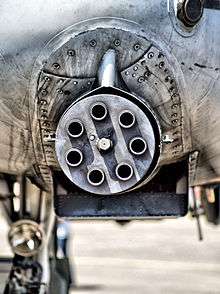
The gun is placed slightly off center in the nose of the plane with the front landing gear positioned to the right of the center line, so that the actively firing cannon barrel is directly on the aircraft's center line. The Russian Gryazev-Shipunov GSh-6-30 is a similar class of weapon; lighter with a higher rate of fire, though with a far lower muzzle velocity and tendency to overheat.
The A-10 and its GAU-8/A gun entered service in 1977. It was produced by General Electric, though General Dynamics Armament and Technical Products has been responsible for production and support since 1997 when the division was sold by Lockheed Martin to General Dynamics.[3]
The gun is loaded using Syn-Tech's linked tube carrier GFU-8/E 30 mm Ammunition Loading Assembly cart. This vehicle is unique to the A-10 and the GAU-8.[4]
Design
The GAU-8 itself weighs 620 pounds (280 kg), but the complete weapon, with feed system and drum, weighs 4,029 pounds (1,828 kg) with a maximum ammunition load. It measures 19 ft 5 1⁄2 in (5.931 m) from the muzzle to the rearmost point of the ammunition system, and the ammunition drum alone is 34.5 inches (88 cm) in diameter and 71.5 inches (1.82 m) long.[5] Power for operating the gun is provided by twin hydraulic motors pressurized from two independent hydraulic systems. The magazine can hold 1,174 rounds, although 1,150 is the typical load-out. Muzzle velocity when firing Armor-Piercing Incendiary rounds is 1,013 m/s, almost the same as the substantially lighter M61 Vulcan's 20 mm round, giving the gun a muzzle energy of just over 200 kilojoules.[6]
The standard ammunition mixture for anti-armor use is a five-to-one mix of PGU-14/B Armor Piercing Incendiary, with a projectile weight of about 14.0 oz (395 grams or 6,096 grains) and PGU-13/B High Explosive Incendiary (HEI) rounds, with a projectile weight of about 13.3 oz (378 grams or 5,833 grains).[7] The PGU-14/B's projectile incorporates a lightweight aluminum body, cast around a smaller caliber depleted uranium penetrating core.[8] The Avenger is lethal against tanks and all other armored vehicles.[9]
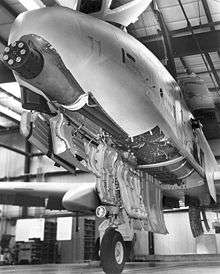
A very important innovation in the design of the GAU-8/A ammunition is the use of aluminum alloy cases in place of the traditional steel or brass.[10] This alone adds 30% to ammunition capacity for a given weight. The projectiles incorporate a plastic driving band to improve barrel life. The shells are imposing to examine and handle, measuring 11.4 inches (290 mm) in length and weighing 1.53 pounds (0.69 kg) or more.[5][10]
The Avenger's rate of fire was originally selectable, 2,100 rounds per minute (rpm) in the low setting, or 4,200 rpm in the high setting.[11] Later this was changed to a fixed rate of 3,900 rpm.[12] In practice, the cannon is limited to one and two-second bursts to avoid overheating and conserve ammunition; barrel life is also a factor, since the USAF has specified a minimum life of at least 20,000 rounds for each set of barrels.[13] There is no technical limitation on the duration the gun may be continuously fired, and a pilot could potentially expend the entire ammunition load in a single burst with no damage or ill effects to the weapons system itself. However, this constant rate of fire would shorten the barrel life considerably and require added barrel inspections and result in shorter intervals between replacement.
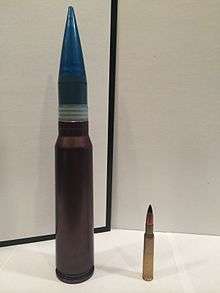
Each barrel is a very simple non-automatic design having its own breech and bolt. Like the original Gatling gun, the entire firing cycle is actuated by cams and powered by the rotation of the barrels.[10] The barrels themselves are driven by the aircraft's dual hydraulic system.[13]
The GAU-8/A ammunition is linkless, reducing weight and avoiding a great deal of potential for jamming. The feed system is double-ended, allowing the spent casings to be recycled back into the ammunition drum,[14] instead of ejected from the aircraft, which would require considerable force to eliminate potential airframe damage. The feed system is based on that developed for later M61 installations, but uses more advanced design techniques and materials throughout, to save weight.[5]
Firing system
Accuracy
The GAU-8/A is extremely accurate and can fire 4,200 rounds per minute without complications. The 30-mm shell has twice the range, half the time to target, and three times the mass of projectiles fired by guns mounted in comparable close air support aircraft.[1]
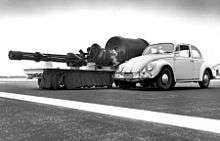
The muzzle velocity of the GAU-8/A is about the same as that of the M61 Vulcan cannon, but the GAU-8/A uses heavier ammunition and has superior ballistics. The time of flight of its projectile to 4,000 feet (1,200 m) is 30 percent less than that of an M61 round; the GAU-8/A projectile decelerates much less rapidly after leaving the barrel, and it drops a negligible amount, about 10 feet (3.0 m) over the distance. The GAU-8/A accuracy when installed in the A-10 is rated at "5 mil, 80 percent", meaning that 80 percent of rounds fired will hit within a cone with an angle of five milliradians. According to Dennis R. Jenkins, author of Fairchild-Republic A/OA-10 Warthog, 5 milliradians equates to a 40 feet (12 m) diameter circle at the weapon's design range of 4,000 feet (1,200 m).[15] However, according to Charles-Marc Dapples's milliradian system an angle of 5 milliradians equates to 20 feet (6 m) at 4,000 feet (1,200 m). By comparison, the M61 has an 8-milliradian dispersion.[10][16]
Recoil
Because the gun's recoil forces could push the entire plane off target during firing, the weapon itself is mounted laterally off-center, slightly to the portside of the fuselage centreline, with the actively "firing" barrel in the nine o'clock position (when viewed from the front of the aircraft), so that the firing barrel lies directly on the aircraft's center line. The firing barrel also lies just below the aircraft's center of gravity, being bore sighted along a line 2 degrees below the aircraft's line of flight. This arrangement accurately centers the recoil forces, preventing changes in pitch or yaw when fired. This configuration also provides space for the front landing gear, which is mounted slightly off-center on the starboard side of the nose.[17]
The GAU-8/A utilizes recoil adapters. They are the interface between the gun housing and the gun mount. By absorbing (in compression) the recoil forces, they spread the time of the recoil impulse and counter recoil energy transmitted to the supporting structure when the gun is fired.
The A-10 engines were initially susceptible to flameout when subjected to gases generated in the firing of the gun. When the GAU-8 is being fired, the smoke from the gun can make the engines stop, and this did occur during initial flight testing.[2] Gun exhaust is essentially oxygen-free, and is certainly capable of causing flame-outs of gas turbines. The A-10 engines now have a self-sustaining combustion section. When the gun is fired the igniters come on to reduce the possibility of a flame-out.[18]
The average recoil force of the GAU-8/A is 10,000 pounds-force (45 kN),[3][19] which is slightly more than the output of one of the A-10's two TF34 engines (9,065 lbf / 40.3 kN each).[20] While this recoil force is significant, in practice a cannon fire burst only slows the aircraft a few miles per hour in level flight.[18]
Variants
Some of the GAU-8/A technology has been transferred into the smaller 25 mm GAU-12/U Equalizer, which was developed for the AV-8B Harrier II aircraft. The GAU-12 is about the same size as the 20 mm M61. GE has also developed the GAU-13/A, a four-barreled weapon using GAU-8/A components, which has been tested in podded form as the GPU-5/A. The Avenger also forms the basis for the Dutch-developed Goalkeeper CIWS naval air-defence gun. No current or contemplated aircraft other than the A-10, however, carries the full-up Avenger system.[5]
Specifications
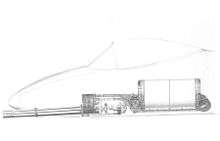
- Precision: 80% of rounds fired at 4,000 feet (1,200 m) range hit within a 40 feet (12 m) diameter circle
- Ammo:
- PGU-14/B API Armor Piercing Incendiary (DU)
- PGU-13/B HEI High explosive incendiary
- PGU-15/B TP Target Practice
- Armor penetration of Armor-Piercing Incendiary ammunition, BHN-300 RHA, attack angle 30 degrees from vertical:[21]
- 76mm at 300 meters
- 69mm at 600 meters
- 64mm at 800 meters
- 59mm at 1,000 meters
- 55mm at 1,220 meters
See also
General:
References
- 1 2 "A-10/OA-10 Thunderbolt II". GlobalSecurity.org.
- 1 2 "GAU-8/A Avenger". National Museum of the USAF. Retrieved 2009-09-14.
- 1 2 3 Goebel, Greg (October 1, 2008). "A-10: Development & Description". Retrieved 2009-09-14.
- ↑ "Turrets & Mounted Weaponry". Retrieved 2009-09-14.
- 1 2 3 4 Spick 2000, p. 44.
- ↑ "Defense Systems: 30mm GAU-8/A Ammunition", Orbital ATK Incorporated, page 2, November 2002.
- ↑ ATK corp. "GAU-8/A Ammunition (30 mm)". ATK. Retrieved 2014-01-09.
- ↑ Stravonski. "Firepower of the A-10". Archived from the original on 2003-04-15. Retrieved 2009-09-14.
- ↑ http://www.dtic.mil/dtic/tr/fulltext/u2/a522397.pdf
- 1 2 3 4 Wagner, Jirka. "30mm cannon GAU-8 Avenger".
- ↑ Stephens, Rick (1995). A-10 Thunderbolt II. World Air Power Journal. p. 18. ISBN 1-874023-54-9.
- ↑ Time Compliance Technical Order 1A-10-1089, Flight manual TO 1A-10A-1. 1-150A (Change 8 ed.). United States Air Force. 20 February 2003. p. vi.
- 1 2 "Fact Sheet: General Electric GAU-8/A "Avenger" 30mm Cannon". Hill Air Force Base.
- ↑ "GAU-8 Avenger". Retrieved 2005-04-27.
- ↑ Jenkins 1998, pp. 64–73.
- ↑ "GAU-8 Avenger". Retrieved 2009-09-14.
- ↑ "A-10 Described: GAU-8 Cannon / External Stores". Vectorsite.net. Retrieved 10/1/2008. Check date values in:
|access-date=(help) - 1 2 Jenkins, Dennis R (1998). Fairchild-Republic A/OA-10 Warthog. North Branch, Minnesota: Specialty Press. ISBN 1-58007-013-2.
- ↑ "Armament Systems: Aircraft Gun Systems". General Dynamics Armament and Technical Products. Retrieved 6 March 2014.
- ↑ "TF34 Engine". GlobalSecurity.org. Retrieved 2009-09-14.
- ↑ Berko Zecevic, Jasmin Terzic, Alan Catovic, Sabina Serdarevic-Kadic."Dispersion of PGU-14 ammunition during air strikes by combat aircraft A-10 near urban areas", page 800. University of Sarajevo, Mechanical Engineering Faculty, Sarajevo, Bosnia and Herzegovina. April 21 2010.
- Spick, Michael. The Great Book of Modern Warplanes, Salamander Books, 2000. ISBN 1-84065-156-3.
External links
| Wikimedia Commons has media related to GAU-8 Avenger. |
- General Electric GAU-8/A Avenger on USAF National Museum site
- GAU-8 Avenger, Hill Aerospace Museum, fas.org
- General Dynamics Ordnance and Tactical Systems GAU-8/A page
- Video of the GAU-8 Avenger test firing

